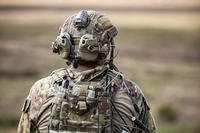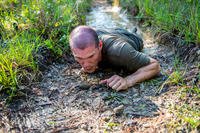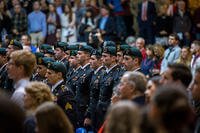Several years ago, Michael Mauritz of Turtle Creek, Pa., received a letter from an Italian historian. "A U.S. P-40 has been discovered intact off of the Anzio beachhead," the historian wrote. "We believe that you were its pilot."
The Italian group excavating the aircraft, the only known intact P-40, sent letters to all the Michael Mauritzes they could locate in the United States. With the first letter they sent out, they had found the very man they sought.
On Jan. 31, 1944, Army Air Corps Lt. Michael Mauritz was forced to make a deadstick landing, the most difficult kind, when his coolant temperature reached 150 degrees. Mauritz knew he was coming into enemy territory. Nevertheless, he executed his landing perfectly, which is why his plane has survived.
But then, "everything about this story is serendipitous," says Francine Costello, who is writing a book about Mauritz's wartime experience. "There are so many remarkable coincidences and overlaps in his journey."
Mauritz was captured almost immediately in the marshy territory near where he landed and taken to an Axis POW camp near La Turina. While a prisoner, he remembers being paraded through the streets of Rome with other prisoners. He recalls that the Italians were "very quiet" during this parade. "[The Germans] made them come out to watch us," he said. "By remaining quiet instead of cheering like they were supposed to, they were making a statement… that they supported us."
After nine days in the prison camp, Mauritz and Marine Capt. Charles Shunstrom, one of the famous "Darby's Rangers," escaped. The two were ill clothed and ill fed, out in enemy territory in the middle of winter. Shunstrom had naturally dark eyes and hair, but the fairer Mauritz had darkened his hair with shoe polish so he could "pass" as Italian.
The first person they met after escaping from the Axis prison camp at La Turina was an Italian standing in the fields of the no man's land around the camp. Mauritz asked him for a cigarette and was given tobacco and rolling papers. Next, they saw a woman, who gave them sausage and bread then shooed them quickly away. Mauritz realized that they weren't fooling any of these people into thinking they were natives. These experiences of aid were repeated again and again. "We experienced nothing but kindness from the Italians," says Mauritz. "We were never refused food from anyone, anywhere."
On a few occasions they were refused shelter, but almost everywhere, they were allowed at least to sleep in the first-floor stables. Mauritz recalls this as a luxury, since the houses were constructed above the stables because of the animals' warmth. Besides, if the homeowners were caught sheltering American "scapati" (escapees), they could claim the fugitives had hidden in the stables. At one point, the two men took shelter with the Italian "patriote" in the mountains.
The Americans' goal was to walk from La Turina in Tuscany to the Adriatic Coast at Ancona, where British subs patrolled regularly and sometimes surfaced to look for escapees. It took five months for Mauritz and Shunstrom to make this journey.
When Mauritz's plane was discovered in 1996, it was millionaire Mariano di Pasquale, Europe's largest flower exporter, who paid for the P-40's salvage. The child of a poor Sicilian family during the war, he has never forgotten the part Americans played in its end. In 1998, he brought Mauritz and his family to Italy for a celebration.
At one dinner there, Mauritz told part of his story, recalling the first kindness shown to him outside the prison fences when a man gave him cigarette-making supplies. A local attendee stood up and said, "That was my father!" Mauritz and his P-40 will always have a place in Italian hearts.















